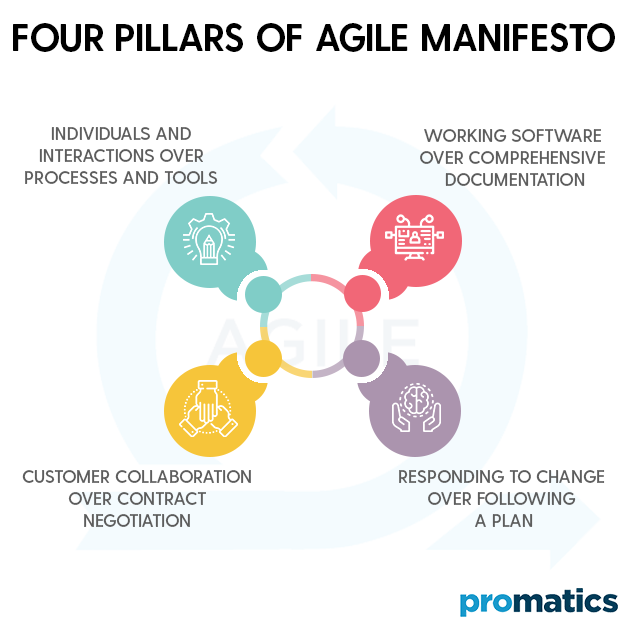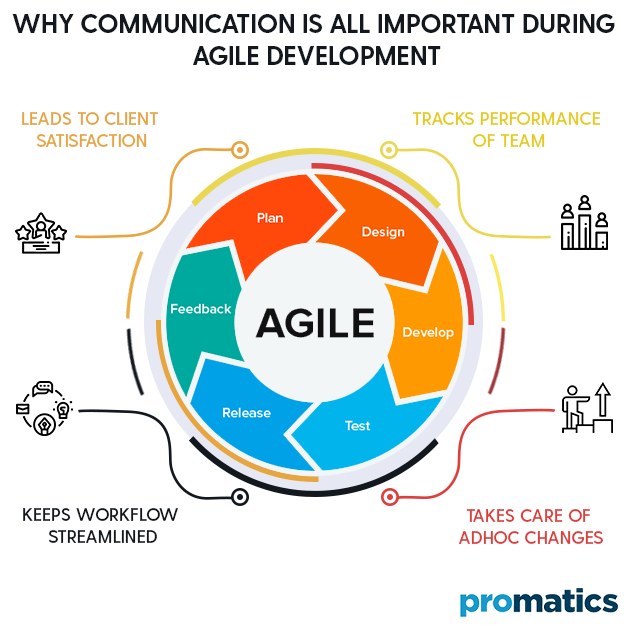How to master the most important aspect of Agile Development?
What is Agile Development?
A simple dictionary search for the meaning of the word ‘agile’ leaves us with a definition ‘able to move quickly and easily i.e. adaptable.’ When it comes to software development, Agile Development denotes a particular method of project management that warrants the execution of tasks into short phases of work and frequent reassessment and adaptation of workflow. Manifesto of Agile Software Development, is a unique set of practices that tend to fuel speed and quality into the otherwise time-consuming and error-laced process of software development.
4 Values of the Agile Manifesto
The Agile Manifesto iterates four foundational values for software developers to abide by. These values can be applied in different senses in each developmental process but they all work towards achieving high-quality end results. Here are the 4 values and their distinct emphasis on agile communication:
1. Individuals and Interactions Over Processes and Tools
The Manifesto clearly states that it is important to value interactions with the client and within the team and not just the documented process of development and tools used. It iterates how individuals form the centre of all developmental activities and not just automated tools. If the developmental process is more mechanised, the team participates less and finds it difficult to adapt to changes, leading to performance failures of the final product. Only effective communication can make the developmental procure individual-centric rather than process centric. When the process is individual-centric, communication is fluid and happens when as and when the need arises. However, in the case of a process, communication is often mechanised and requires specific content.
2. Working Software Over Comprehensive Documentation
Age old software development practices required extensive documentation of the product for development and ultimate delivery. The team documented technical specifications, technical requirements, technical prospectus, interface design documents, test plans, documentation plans, and approvals that were required for each of these steps. This added to the cost and time of development in massive ways. Agile development streamlines the workflow by reducing the need for redundant documentation and increasing the emphasis of synched working teams.
3. Customer Collaboration Over Contract Negotiation
Negotiations are savage working out of the important details of the project. On the other hand, collaborations ensure that the customer is engaged throughout the development process through effective communication practices. This not only ensures that the final product meets the expectations of the clients but also makes it possible to implement changes in a timely fashion. The agile developmental process ensures that clients are engaged at regular intervals through periodic demos, meetings and discussions etc.
4. Responding to Change Over Following a Plan
Following the traditional developmental processes meant labelling ‘change’ as an expense. It required the development of detailed, elaborate plans, with pre-defined features along with having a set pre-determined workflow. Embracing Agile means allowing the scope for shifting priorities from iteration to iteration. Agile appreciates changes and the improvement that a change bring along. Agile methodologies allow the developmental teams to change the process through close-knit communication channels.
Importance of Communication in Agile Development
Principles behind the Agile Manifesto lay vivid emphasis on the communication clause when it comes to Agile Development practices.
a.) It mentions that satisfaction of the customer as its highest priority. Only effective communication ensures that the development team comprehends what the client expects out of the final product, which can guarantee client satisfaction.
b.) The principles specify embracing changing requirements, even at later stages in development. A close-knit team that communicates at every stage can collectively discover the need for change and implement it easily while keeping the client in the loop.
c.) A team working collectively and in a transparent fashion can deliver any working software in a short span than a team that lacks communication due to the streamlined workflow.
d.) Effective communication ensures motivated individuals are given their due in the form of appreciation and support. This further incentivizes them to give their best.
e.) The principles tout face-to-face conversations to and within a development team as the most efficient and effective method of conveying information.
Our Experience with Agile Development
The golden principle that fortifies business partnerships is good communication. As a mobile app development company, we constantly strive to figure out what our business clients expect out us. It remains our motive to add value to the app products we develop while being flexible to the needs of our clients. The secret to success behind serving our clients the best lies in all the efforts we put in knowing them and their history. Having some context about the clients gives us a strategic edge in dealing with their needs. Additionally, we maintain an organic flow of communication with our clients throughout the project cycle so that we are abreast with evolving business requirements, vision, priorities, goals, and key stakeholders and their roles. This paves an easy way for open creative dialogue, keeps client and us on the same page about the challenges and progress of the project. Such practices are imperative for the success of Agile project plans.
We have been in business with prestigious clients in the industry for some time now, to know well enough that even the best quality apps come with bugs in the beginning. A close-knit, transparent relationship between all stakeholders ensure collaborative solutions to the problems spring up as soon as does the problem. Working in close partnership with the clients also helps us work proactively on new ideas and challenges. Knowing the strategic ways and timing of conducting the communication with a client also add enormously to the final outcome. However, it all begins with attentive listening. Listening with intent ensures that you develop a clear cut understanding of what is expected out of your work.
Here are some best practices that help maintain an effective workflow of information:
I. Synching Up- Having a client on the loop at all times through regular in-person meetings/video conferences and telephone conversations ensures that the workflow is streamlined and all stakeholders remain up-to-date.
II. Familiarity Session- Conduct a team-wide familiarity session with the client. This will ensure that all the people working on a particular project become familiar with the client through fun ways. This also helps unravel the expectations of the client from the product and helps the team understand it better.
III. Listicles- There should be a common thread of shared lists that contain issues, discuss the requirements and goals of the project. Stay on track as a team.
IV. Real-Time Communication- Count emails old school, with new age instant messengers which help all to stay connected in real time. Thought provoking conversations with the team reinforces creative collaborations and equitable responsibility at the workplace.
V. Share Honest Feedback- It’s wonderful to appreciate and rewards teammates that outperform app development. It encourages them to think ‘outside of the box’ and bring in good ideas. Appreciation for hard-working teammates reiterates your focus on quality in the app product.
Summary
In the end, it’s fair to claim that the success of any technological development project begins with clear and free-flowing communication between all stakeholders. Good and open communication between the team and the client streamline workflow, mitigates risks, enhances productivity ensuring all the while that the final product is in sync with the business’s expectation. Thus Agile Development calls for agile communication as an essential element.
Still have your concerns?
Your concerns are legit, and we know how to deal with them. Hook us up for a discussion, no strings attached, and we will show how we can add value to your operations!


